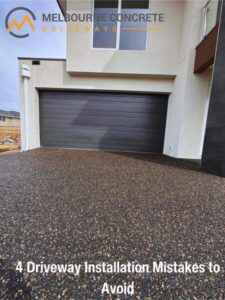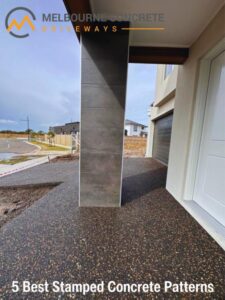The 6 tips for a crack-free concrete driveway are forming a stable base, utilising a plate compactor, dampening the base, ensuring forms are aligned, keeping formwork secure, and using enough steel reinforcing. By following these tips, you can increase the chances that your driveway will last for many years.
In this blog, we’ll discuss the 6 tips concreters in Melbourne recommend to ensure maximum lifespan for your new concrete driveway.
Tip #1: Form a Solid Base
A solid base is essential for preventing cracks. This base should consist of compacted, non-organic material.
Opt for a depth of at least 100mm for optimum strength. Gravel or crushed rock serves well as they provide drainage and structural support.
Ensure the surface is level; uneven bases can lead to stress points in the concrete, causing cracks.
Tip #2: Utilise a Plate Compactor
Compacting the base material is crucial, and a plate compactor is ideal for this task. It efficiently compresses the sub-base, eliminating air gaps that could weaken the driveway.
A well-compacted base provides a stable foundation and significantly reduces the risk of cracking. Compact in layers, not exceeding 50mm per layer for best results.

Tip #3: Dampen the Base
Before pouring concrete, moisten the base lightly. This prevents the base from absorbing water from the concrete mix needed for curing.
Be mindful to avoid over-wetting; the base should be damp, not waterlogged. A balanced moisture content helps in achieving a uniform cure and minimises the risk of cracking.
Tip #4: Ensure Forms Are Aligned
Proper alignment of forms is critical for a smooth, crack-free surface. Forms create the boundary and shape of your driveway. Check that they are straight and level, using a spirit level.
Any inaccuracies in form alignment can result in uneven thickness of the concrete slab. When this happens, it predisposes it to cracks.
Tip #5: Keep Formwork Secure
Sturdy formwork supports the concrete’s shape during setting. Brace forms firmly to prevent shifting or bulging, leading to an uneven surface and potential cracking.
Use strong stakes regularly and ensure they’re driven deeply enough for stability. Regular checks during the pour are advisable to maintain correct positioning.
Tip #6: Use Enough Steel Reinforcing
Incorporating steel reinforcing mesh or bars strengthens the driveway and controls cracking. The steel should be positioned centrally in the slab’s thickness.
For domestic driveways, SL72 mesh is often used. Ensure there’s adequate cover of concrete over the steel to prevent rusting, which could weaken the structure and lead to cracks.
By following the tips mentioned above, you should have a good idea of how to lay a concrete driveway the right way.






